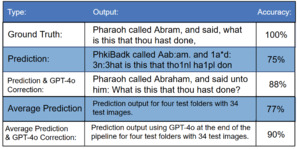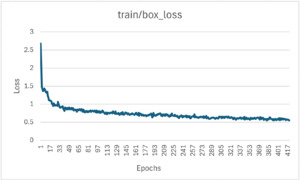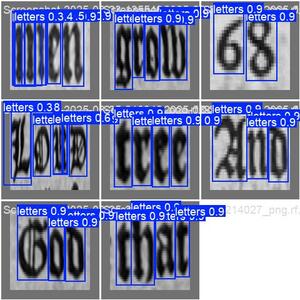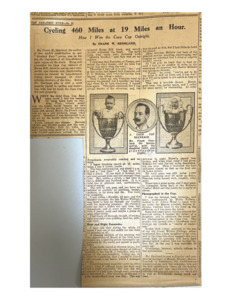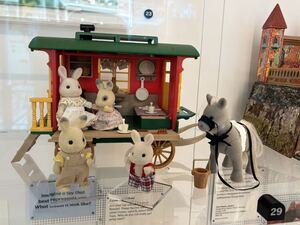
Browse Items (226 total)
Sort by:
-
Table of Results from Automated Transcription Pipeline
A table that holds the results from testing for the automated transcription pipeline. -
Layout for Letter Recognition Pipeline
The layout of the pipeline for the automated transcriber. It shows the input from a 1613 Bible, object detected, cropped, then transposed to a letter. -
Object Detection Bounding Box Loss Plot
The loss plot for the bounding boxes from a YOLOv12 object detection model. Used to detect letters in a word. -
YOLOv12 Object Detection Validation Prediction Results
The results from the validation test set for the YOLOv12 object detection model for the automated transcriber pipeline. -
Mary Shelley - Letter to Percy Bysshe Shelley (Audio)
"Shelley was now financially responsible for Mary and Claire as well as Harriet, who was heavily pregnant with their second child. Godwin refused to see him, but drew on his resources. Mary wrote this impassioned letter to Shelley when he was in hiding from his numerous creditors. They could meet only on Sundays, when it was illegal to make arrests for debt."
-
Mary Shelley - Journal of Sorrow (Audio)
"In the months immediately following Shelley's death Mary lived at Albaro on the outskirts of Genoa. Her only regular companions were her young son, Percy Florence, and the journal she began on 2 October 1822.
To this 'Journal of Sorrow' she confided her innermost thoughts: 'White paper - wilt thou be my confident? I will trust thee fully, for none shall see what I write.' To be sure, Mary would not have shared the entries she wrote immediately after Shelley's death, in which her remorse and despair sometimes approached hysteria. But she left no instructions for the 'Journal of Sorrow' to be destroyed after her death, and was perhaps reconciled to the idea that this, and her other journals, would eventually be seen by other eyes." -
Percy Bysshe Shelley - Letter to Mary Shelley (Audio)
"'Everybody is in despair and every thing in confusion' writes Shelley in his last letter to Mary. He was in Pisa to discuss a new journal, The Liberal, with Leigh Hunt and Lord Byron.
Shelley had been delayed there by Hunt's personal situation (his wife Marianne had been told she did not have long to live) and by Byron's complicated affairs. He hints that Edward Williams might sail back to the Villa Magni ahead of him. Hurriedly concluding the letter, Shelley hopes that Mary was reconciled to staying at the Villa Magni, where he had never been happier, but where she had been ill and wretchedly depressed. In a PS he tells her that he has found the manuscript of his translation." -
Percy Bysshe Shelley and Mary Shelley - Joint journal entry (Audio)
"Shelley and Mary eloped at 4.15 am on 28 July 1814, accompanied by Mary's step-sister Jane Clairmont. They were pursued by Mrs Godwin (Claire's mother), who caught up with them the following day at Calais, but failed to persuade them to return. On 2 August Shelley, Mary and Claire reached Paris, where they purchased this notebook. Shelley wrote up their dramatic flight from England, the stormy crossing (during which he began 'to reason upon death') and their arrival in France. Mary makes her first contribution to the journal by lightly completing a sentence: 'Mary was there. Shelley was also with me.'" -
Cycling 460 Miles at 19 Miles an Hour
This is an article from an unknown magazine or newspaper which is authored by Frank Shorland and is about how me won the Cuca Cocoa Challenge Cup. -
Sylvanian Families Horse-Drawn Caravan
The Sylvanian Families Horse Drawn Caravan offers a charming glimpse into a nomadic lifestyle often romanticized in British culture. Pulled by a gentle grey horse with a harness, the green and red caravan features a cozy interior with windows, a door, and even a small cooking area visible. This playset evokes images of traditional Romani caravans and the history of traveling communities in Britain, representing a sense of freedom and connection to the countryside. It's a sweet miniature portrayal of a mobile home, reminiscent of vintage British fairground or countryside living.
